Read more
"This timely update provides detailed treatment of the integration of wind power into electrical power systems, including brand new material on offshore wind power farms and technologiesThis third English edition is based on new material from the fourth and fifth German editions (Windkraftanlagen: Systemauslegung, Netzintegration und Regelung, 5. Auflage, published by Teubner B.G. Gmbh, July 2009). It answers the question of how, with the proper control and direction, wind turbines can be made to operatemore similarly to conventional power plants. The revised third edition addresses the engineering challenges of cost effective transmission and distribution of wind power, such as technical, economic and safety issues. It also incorporates all the recent technical developments in electrical power conversion systems and essential operating conditions, and includes unique, original research findings carried out by the author's own PhD and Masters students at Kassel University, Germany. This popular reference book has been updated to include new material from the fourth and fifth German editions, equating to 12.5% brand new material New material covers the 'hot topic' of grid connection for offshore wind farms and offshore technologies, including lots of illustrations Brand new material on low voltage fault dynamics and control of turbines Includes up-to-date coverage on completely new generator developments for wind turbines, developed over the past two years Illustrates how wind turbines can operate like conventional power plants using advanced control systems. Discusses the profitability of wind turbine integration in electrical power grids, and the environmental impact "--
List of contents
Preface xi
Notation xiii
1 Wind Energy Power Plants 1
1.1 Wind Turbine Structures 1
1.2 A Brief History 4
1.3 Milestones of Development 5
1.4 Functional Structures of Wind Turbines 20
References 30
2 Wind Energy Conversion Systems 31
2.1 Drive Torque and Rotor Power 31
2.1.1 Inputs and outputs of a wind turbine 31
2.1.2 Power extraction from the airstream 32
2.1.3 Determining power or driving torque by the blade element method 34
2.1.4 Simplifying the computation method 38
2.1.5 Modeling turbine characteristics 40
2.2 Turbines 46
2.2.1 Hub and turbine design 50
2.2.2 Rotor blade geometry 51
2.3 Power Control by Turbine Manipulation 57
2.3.1 Turbine yawing 57
2.3.2 Rotor blade pitch variation 67
2.3.3 Limiting power by stall control 97
2.3.4 Power control using speed variation 100
2.4 Mechanical Drive Trains 102
2.5 System Data of a Wind Power Plant 108
2.5.1 Turbine and drive train data 108
2.5.2 Machine and tower masses 110
2.5.3 Machine costs 111
References 116
3 Generating Electrical Energy from Mechanical Energy 119
3.1 Constraints and Demands on the Generator 119
3.2 Energy Converter Systems 122
3.2.1 Asynchronous generator construction 125
3.2.2 Synchronous generator construction 126
3.3 Operational Ranges of Asynchronous and Synchronous Machines 126
3.4 Static and Dynamic Torque 132
3.4.1 Static torque 133
3.4.2 Dynamic torque 147
3.5 Generator Simulation 154
3.5.1 Synchronous machines 155
3.5.2 Asynchronous machines 160
3.6 Design Aspects 161
3.6.1 Asynchronous generators 162
3.6.2 Synchronous generators for gearless plants 174
3.6.3 Multi-generator concept (Dissertation A. Ezzahraoui) 187
3.6.4 Ring generator with magnetic bearings (Dissertation K. Messol) 194
3.6.5 Compact superconductive and other new generator concepts 197
3.7 Machine Data 199
3.7.1 Mass and cost relationships 200
3.7.2 Characteristic values of asynchronous machines 202
3.7.3 Characteristic values of synchronous machines 204
References 208
4 The Transfer of Electrical Energy to the Supply Grid 210
4.1 Power Conditioning and Grid Connection 210
4.1.1 Converter systems 212
4.1.2 Power semiconductors for converters 215
4.1.3 Functional characteristics of power converters 218
4.1.4 Converter designs 222
4.1.5 Indirect converter 223
4.1.6 Electromagnetic compatibility (EMC) 236
4.1.7 Protective measures during power conditioning 237
4.2 Grid Protection 238
4.2.1 Fuses and grid disconnection 239
4.2.2 Short-circuiting power 239
4.2.3 Increase of short-circuit power 242
4.2.4 Isolated operation and rapid auto-reclosure 245
4.2.5 Overvoltages in the event of grid faults 247
4.3 Grid Effects 247
4.3.1 General compatibility and interference 247
4.3.2 Output behavior of wind power plants 248
4.3.3 Voltage response in grid supply 260
4.3.4 Harmonics and subharmonics 271
4.3.5 Voltage faults and the fault-ride-through (FRT) 279
4.4 Resonance Effects in the Grid During Normal Operation 284
4.5 Remedial Measures against Grid Effects and Grid Resonances 290
4.5.1 Filters 290
4.5.2 Filter
About the author
Professor Siegfried Heier,
Universitaet Kassel, Institut fuer Elektrische Energietechnik, Germany Siegfried Heier is currently the Head of the Wind Engineering department at Kassel University, Germany. He has been a Professor at the university since 1979. He is the initiator and head of many research projects in the field of wind engineering and he has published more than 70 articles about generator systems, and control and grid integration of wind energy converts. Professor Heier has also written books in the area, such as
Windkraftanlagen (B.G. Teubner), now in its 5
th Edition. Siegfried currently holds two patents.
Summary
This popular reference describes the integration of wind-generated power into electrical power systems and, with the use of advanced control systems, illustrates how wind farms can be made to operate like conventional power plants.

